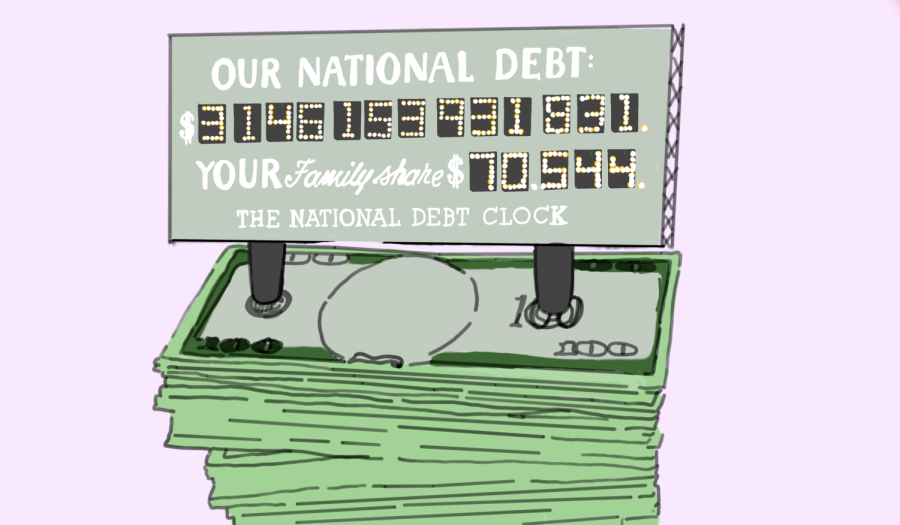The Debt Ceiling Crisis
Photo by Joan Chong/ UCSD Guardian
May 15, 2023
From all the news regarding Donald Trump’s indictment or Joe Biden’s re-election announcement, perhaps the biggest story at the moment is the situation concerning the national debt ceiling. Treasury Secretary Janet Yellen has warned that the U.S. could breach the ceiling by June 1 and that doing so leaves the nation with “simply no good options.” So what exactly is the debt ceiling, why is it not being raised, what are the demands of Democrats and Republicans, and how will this crisis be resolved? It seems clear that both sides must accept concessions, despite their desired political goals. But the fact that neither has budged on their negotiating position highlights the ramifications of the ceiling and its importance to both sides.
What is the Debt Ceiling?
The debt ceiling is essentially the limit of government borrowing. The ceiling was enacted by Congress in World War I to ensure that the government could borrow money unimpeded but only up to a certain amount. Lifting the ceiling was historically apolitical as it has occurred 78 times since 1960. However, it has become more controversial in recent years, most notably in 2011 when President Obama faced off against Speaker Boehner and House Republicans and was forced to swallow spending cuts to lift the ceiling.
Who Opposes Raising the Ceiling? Why?
Congressional Republicans recently passed the Limit, Save, and Grow Act. The Act is dead on arrival in the Democratic-led Senate but outlines the negotiating position of House Republicans. The bill increases the ceiling by $1.5 trillion, but cuts $1.47 trillion in the next fiscal year and enacts a 1% spending cap increase after that. The Congressional Budget Office, which scores legislation based on its impact on the deficit, says the bill will cut federal spending by $4.8 trillion over the next ten years.
Democrats oppose attaching spending cuts to lifting the ceiling. This position is twofold. Firstly, Democrats are historically the party that favors greater government spending and stronger welfare programs. Social Security and Medicare are two government programs Biden has vowed to protect — a position popular with the public — and he has made a political case out of some Republicans’ plans to cut or phase out these policies. Secondly, Biden and the Democrats often point to the three times the ceiling was raised or waived during the Trump administration without objection by Republicans as evidence of the political weaponization of the debt.
What Are the Likeliest Outcomes? Are There More Out-of-the-Box Solutions?
The outcome that Wall Street and most Americans are hoping for is a negotiated settlement. What form this settlement takes is unclear — Democrats may accept cuts to defense spending but not much else, while Republicans need to walk away with some form of substantial deficit reduction to justify cutting a deal. Complicating this is Kevin McCarthy’s precarious position as the top House Republican; with his right flank demanding no mercy, he is unlikely to accept a deal unless it mimics the bill already passed in the House (a bill the White House has already slammed).
With these talks stalled, several economists and pundits have floated other mechanisms for raising the ceiling. The most unique of these is the minting of a trillion-dollar coin by the Treasury. Both Yellen and Chair of the Federal Reserve Jerome Powell have dismissed the idea, but it has gained traction in some corners. Depositing this coin in the Federal Reserve would allow the Treasury to use it to keep paying its bills until an agreement is reached or another coin is minted. The main drawbacks to this approach are its legality and how markets will react to it. It could also set a dangerous precedent of the Treasury bypassing Congress whenever it takes time to act.
Another idea, perhaps even more fringe, utilizes a particular reading of the Constitution’s 14th amendment: “The validity of the public debt, authorized by law … shall not be questioned.” This has led some scholars to argue that the Constitution authorizes the President to do whatever is necessary to preserve the debt, including bypassing Congress. The legality of this is certainly questionable and could delay its implementation.
With alternative options untested and unclear in their effectiveness, it is evident that Congressional Republicans and Biden must agree on some negotiated settlement. This may involve Democrats swallowing certain cuts (but pushing for them to be defense-related or nonessential in nature) or Kevin McCarthy agreeing to future cuts for a clean increase now. Both must accept something unpopular in the end — that much is clear. This will involve a certain degree of political risk-taking, but if both sides take the plunge together, it could alleviate the political side effects. Posturing, in the meantime, helps no one.















